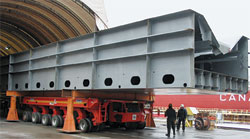|
March 2005 IBEW Journal
She was a ship with no
name. Launched on the Great Lakes in 1977, the 736-foot-long
cargo vessel was christened the "Jean Parisien," but
had become known simply as "Hull No. 80," the
next patient in line for a maritime makeover at Port
Weller Dry Docks in St. Catharines, Ontario.

Local 303
member Graeme Adams installs a lighting
junction in tunnel of Hull No. 80. |
Members of IBEW Local
303 are critical players on the makeover
team. Pete Riganelli, a local member and general
foreman, says, "The members get much satisfaction
and pride knowing that we, as a local, contribute
to such a complex and interesting project as
the refurbishment of a Great Lakes vessel."
Strategically located on the Welland Canal at the western
end of Lake Ontario, along part of the St. Lawrence
Seaway system, the Port Weller Dry Docks has long
offered inland and ocean-going vessel owners the
facilities to build, convert, refit or repair their
ships. On blocks or afloat, the ships benefit from
the skills of the areas highly unionized trades.

Cometto, a mobil transporter capable
of carrying a
payload of 150 tons, removes tunnel section from
paint tent. |
Members of Boilermakers
Local 680 survey Hull No. 80s cargo hold, no longer
seaworthy after years of relentless battering between
pounding waves and the shifting, mountainous stores
of salt, coal, iron ore and stone it carried. They
examine the corroded cranes and conveyors, finished
after years of dutifully unloading their bounty at
ports like Duluth, Montana, Ashtabula, Ohio, and
Port Cartier, Quebec.
They cut the 600-foot
hold section away from the aft end that houses the
engine room and accommodations, piling up tons of
scrap that will be sold. Welders manipulate 6,000
tons of steel plate, using "The Clyde," a
traveling jib crane with a vertical lift of 130 feet
and a maximum lift capacity of 120 tons. They fabricate
a new 78-foot-wide fore body for the vessel, owned
by Canada Steamship Lines Inc., which, upon completion,
will carry approximately 30,000 tons of free flowing
cargo.
More >>
|
